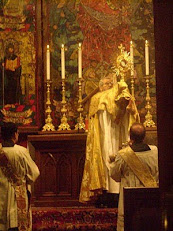On the web site of the Church of St. Michael the Archangel, Philadelphia, Fr. Ousley has posted a presentation that compares the new Ordinariate rite with the rite in the Book of Divine Worship. The presentation helpfully notes, not only the changes, but also the reason for the changes. In most cases, the changes represent a restoration of more traditional Anglican practices and formularies. The first page is shown below, but you can download the entire PDF of the presentation at the church's web site.
With the new Eucharistic rite's inauguration, the material in the Book of Divine Worship which remains normative has been further reduced. The funeral and marriage rites had been previously supplanted, as had Rite II of the Eucharist. All that remains as normative are the Daily Office, the Litany and Baptism. Doubtless, the Baptismal rite will be the next to be revised and published. I doubt we will see much change in the Litany, and so it remains to be seen what changes will come to the Daily Office. Currently the personal ordinariate of Our Lady of Walsingham uses the texts from the BDW, but uses the psalter from the Customary of Our Lady of Walsingham, owing to differences in the US and English versions of the Coverdale Psalter. There are other differences between the US and English Books of Common Prayer, which are reflected in differences found in the BDW and the Customary, and those differences will have to be addressed by the Anglicanae Traditiones commission.
Obituary of a very failed Pontificate
-
"Nun khre methusthen kai tina per bian ponen, epei de katthane
Mursilos."Such would have been the reaction of the unchristianised Greeks.
But for us, for t...
6 months ago















Thank you. I am much relieved after scanning through it and am glad for the consistency of style in the Tudor English. I had heard it was a 'hodgepodge' of Tudor/modern English.
ReplyDelete